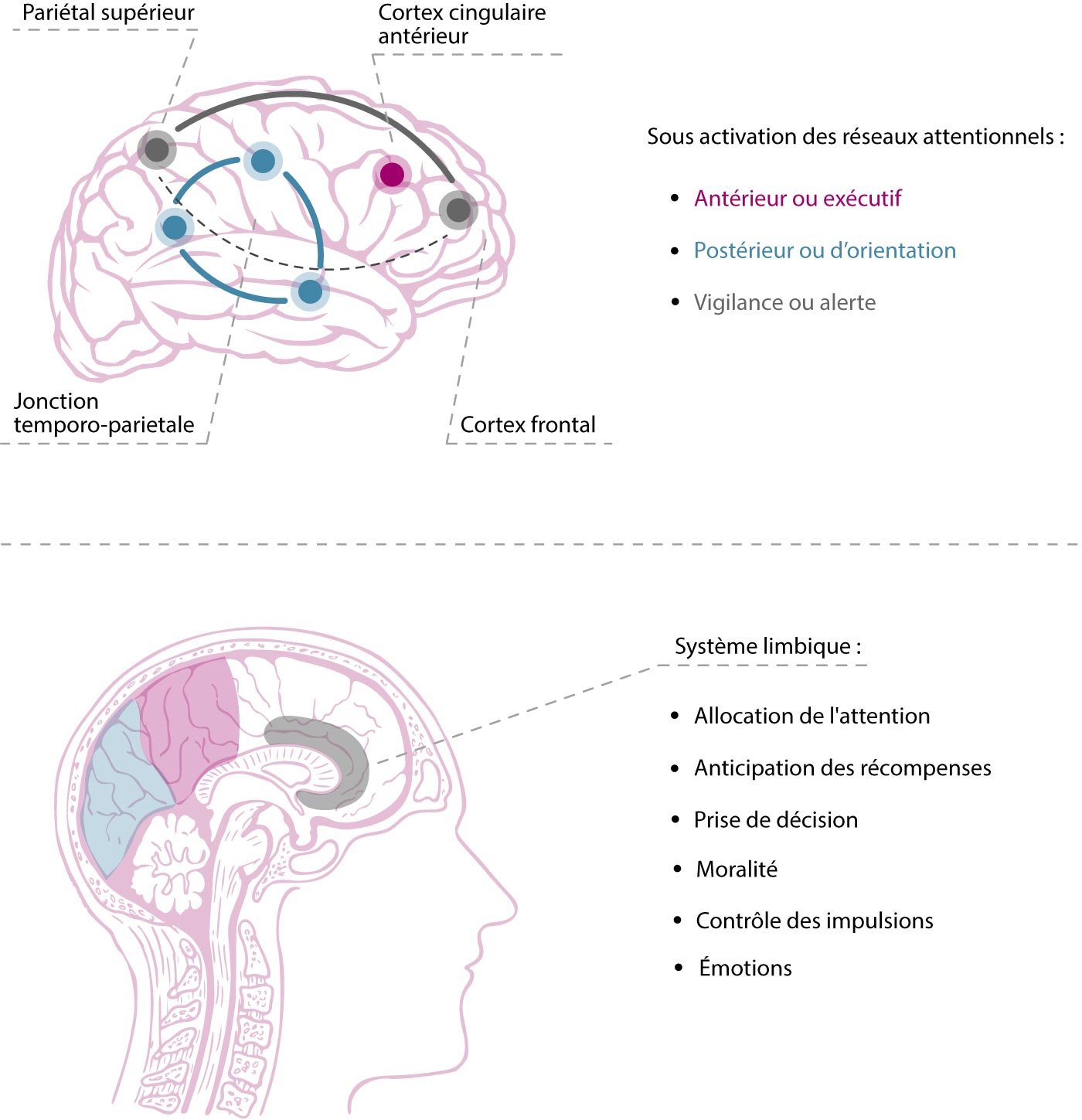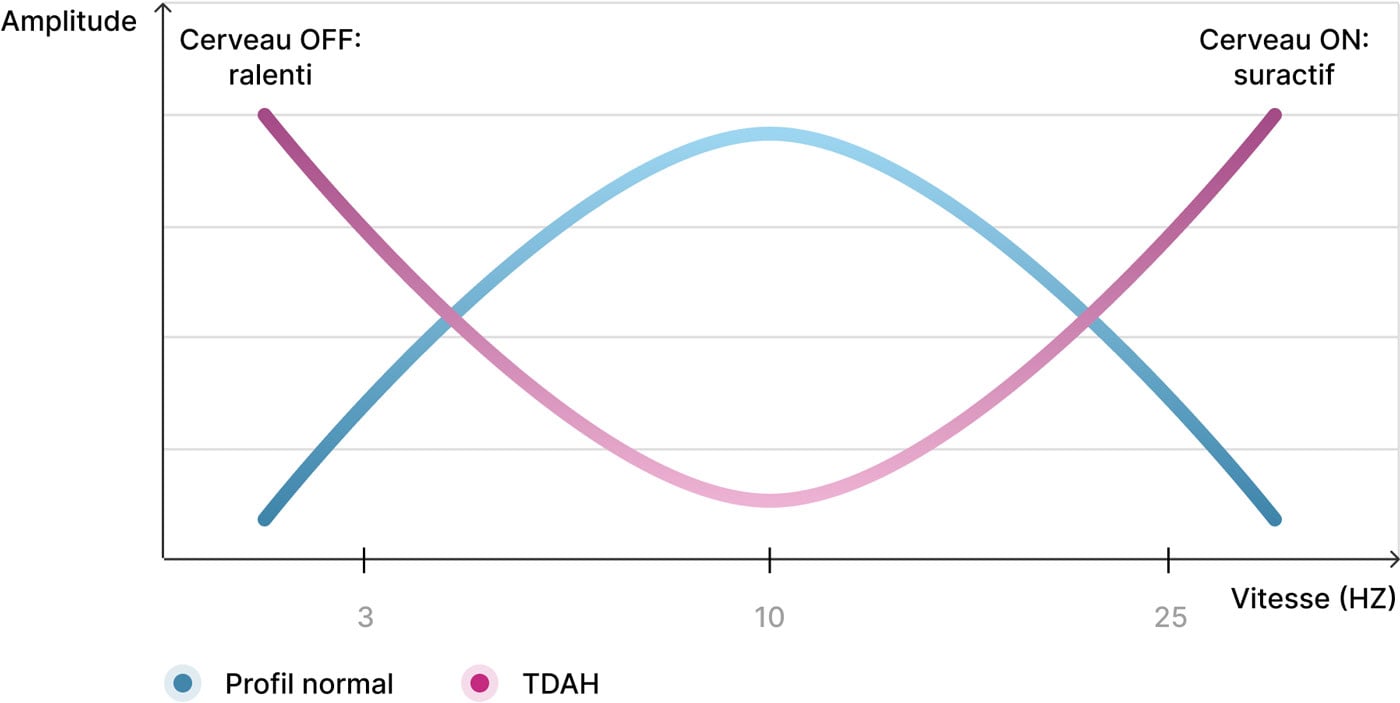
This conference presents how our team works to help those with attention, concentration or learning difficulties. It is accessible in french and english on our youtube channel (and with subtitles).
This technique offers a non-medicated and natural alternative to ADHD treatment. It is not a new treatment, but it remains little known in Europe, although it has existed since 1970. At present, ADHD is the largest field of research studied in this practice which acts directly on the symptoms.

Typical example of a Brainmap (qEEG) of a person diagnosed with ADD(H): increased slow theta waves (in red: slowed down brain, attention and concentration difficulties) and decreased fast beta waves (in blue: sleep disorder, lack of resources and decreased vigilance)
People with this disorder, both children and adults, Neurofeedback regulates the over- or under-activation of brain waves. In addition to the improvement of ADD(H) symptoms, an improvement in school performance takes place in our clients and the maximum benefits will happen 6 months after completing the treatment.
There are many studies attesting to its effectiveness, carried out on a large number of children, in several clinics, with standard scientific protocols known as “randomized”. However, it was not until 2013 that the American Academy of Pediatrics finally recognized it as a Grade 1 effective treatment for the improvement of ADD(H) symptoms. This means that it is recognized as a high-level treatment and should be recommended as a primary option.
Studies also show that neurofeedback is as effective as stimulants (Janssen et al., 2016). This makes it an effective alternative treatment to medication. But, unlike medication, the benefits of neurofeedback are long-lasting – even years after the treatment.
See the relevant page for more information on Neurofeedback →
A person with ADD(H) rarely sleeps well. Ask yourself if you wake up in the morning feeling fit and alert, or if you need time to start the day with four coffees. If you check the second option, then your sleep is not good!
Poor sleep has many negative consequences, including fatigue and decreased recovery, which weakens cognitive functions. A less efficient brain will not be able to concentrate or memorize as effectively. At school, the days can become exhausting and result in learning difficulties. There may even be agitation or behavioral and mood disorders (anger, frustration…).
Neurofeedback has been shown to have a specific effect on sleep and AD(H) symptoms (Arns et al., 2014; van Doren et al., 2018): it improves sleep quality and decreases AD(H) symptoms.
In 2019, Ryan et al. compared the effect of neurofeedback versus medication treatments for ADHD. The results indicate that for some patients, medication does not help or even worsens sleep disturbances in the AD(H) patient. They also find that if sleep disturbances are present, the effect of medications such as stimulants may be attenuated.
Here are the results of a Neurofeedback Luxembourg client after 10 neurotherapy sessions:
Important: please read the disclaimer at the bottom of the page!
This treatment is available without a prescription and is equally suitable for children and adults.
See the relevant page for more information on the Process →
Attention Deficit Disorder with or without Hyperactivity (or ADD/ADHD) is a developmental disorder: it means that the brain develops (hardware) and functions differently (software).
It manifests itself in childhood and persists into adulthood. It affects 5 to 12% of children (1 to 2 children per class!) and more often affects boys. The risk factor of hereditary transmission is very high when a parent presents the symptoms of ADD(H): close to 70%.
ADD(H) is almost always accompanied by other disorders that can aggravate the symptoms:
It would be more accurate to say Attention Dysregulation Disorder with or without Hyperactivity because ADHD is not a difficulty in concentrating, but a difficulty in regulating one’s attention: either the person cannot concentrate as he or she would like to, or he or she enters a state called “hyperfocus” in which he or she does not see the time passing and can forget to eat, for example, because he or she is so concentrated.
ADD(H) is a group of symptoms. Presenting only one, or a part of it, is not enough to make a diagnosis. In addition, some disorders can produce the same symptoms and lead to confusion about the diagnosis (such as anxiety).
But ADD(H) also has superpowers that need to be paid attention to! They are dynamic people; their boundless energy allows them to get to work on a project and to progress rapidly in a job or an activity.
With a flourishing imagination, they are creative and spontaneous. Their ability to think is unusual and original. Developing projects with them is a joy! In addition, they often have a very sharp sense of observation, allowing them to find a solution to any problem.
Once the ADD(H) person discovers a passion, he or she will be motivated and persistent, showing determination until he or she succeeds. Nothing discourages them!
ADD(H) is manifested by an under-activation of attentional brain networks and prefrontal regions (the brain’s orchestra area).
It is very common to also find a decrease in connectivity between the frontal and posterior regions of the brain (called the longitudinal bundle) but also between the precuneus and the anterior cingulate cortex: this is the Default Mode Network (or DMN).

ADHD is a developmental disorder which means that the brain structure develops differently
These differences make it difficult to self-regulate attention. The person is like a switch: either “ON” (energetic, productive, focused) or “OFF” (slowed down, not paying attention). Going from one state to the other and showing nuance requires a lot of energy. She is unable to control herself and adapt to the situation, whether it is her behavior or her attention.
This lack of regulation leads to a disorder of vigilance. Alertness is a state of active attention, when one is ready to face a danger. When this function is deficient, the person with ADD(H), usually restless or energetic, will fall asleep quickly during an unstimulating activity even if he or she does not feel tired.

The brain with ADHD whose curve is inverted compared to a brain without ADHD, a sign of a lack of self-regulation
There is also a decrease in the production of dopamine when one has ADD(H): the neurotransmitter responsible for the sensation of pleasure, reward, and satisfaction.
This decrease leads to the under-activation of the brain’s reward circuit, involved in the process of the same name. Normally, as soon as there is a reward, there is a production of dopamine. This allows us to feel a sensation of pleasure and satisfaction that motivates us.
For a person with ADD(H), it is difficult to maintain attention during exercise because the reward seems meager due to this dopamine deficiency. This explains why a person with ADD(H) focuses his or her attention on several things: his or her goal is to constantly and quickly obtain a satisfying reward.
This dopamine deficiency can also be at the origin of certain dangerous or addictive behaviors. The subject with ADD(H) self-regulates through external stimulation: substance abuse (drugs, coffee…), addictions (sex, cigarettes, work, sports,…), dangerous driving, extreme sports or intensive practice…
Some things make ADD(H) symptoms worse or better than we think. Don’t underestimate their power over our daily lives. Lifestyle plays a crucial role in the good mental health of everyone and the proper functioning of the body and brain. This is even more true for the person with ADHD!
As far as food is concerned, it is absolutely necessary to avoid refined sugar in all its forms! Too much sugar increases nervousness and impulsiveness. Restlessness makes it much more difficult to concentrate and can even lead to feelings of stress. Not to mention the inflammatory risk on the body and brain (increased risk of developing dementia or cancer for example).
It is important to eat a balanced diet and stay well hydrated. An intake of omega 3 and magnesium is recommended for a person with ADD(H).
Sleep affects our attention span and concentration. So it’s important to get enough sleep. For your child, establish routines and rituals: the same bedtime and wake-up time every day. A bedtime ritual helps the brain know it’s time to go to sleep (this is called habituation or conditioning). Try reading a story, playing relaxing music, etc.
Sports are a must! ADD(H) is full of energy. They need to be able to expend it. Physical activity also allows for better elimination of toxins through sweating, muscle stimulation and better motor coordination.
Be sure to limit screen time as much as possible (TV, phone, tablet, console, computer…). It’s a passive activity, with no social interaction that doesn’t allow you to expend any energy. In addition, because of the blue light, it has a direct negative impact on sleep and vision.
To help an individual with ADD(H), his need for structure must be addressed. They have too much difficulty managing their time and organizing themselves efficiently. Establishing a routine with rules from a young age will serve as a reference point.
Among the best known treatments and management of ADHD, medication is almost always the first to be proposed:
There are also recognized and adapted psychotherapies for parents like:
Some of these ADD(H) solutions are better known than others. Medications are effective in some cases but they have a major drawback: their effects and side-effects are not sustainable over the long term. They act directly on the symptoms at the moment. Their benefits fade as soon as they are stopped.
Talk to a specialist over the phone to determine together the solution that best suits your needs and budget.
Free call with no obligation.
We promise we will only send you quality content. You can unsubscribe at any time.
We are not doctors or psychiatrists. Therefore, we do not diagnose, we do not prescribe medication, we do not cure illnesses and we are not an emergency center. We often help people reduce or even stop their medication in agreement with the health professional who follows you. Please note that you do not need a prescription or a diagnosis to make an appointment at Neurofeedback Luxembourg.
We promise we will only send you quality content. You can unsubscribe at any time.
We promise we will only send you quality content. You can unsubscribe at any time.